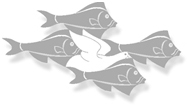

|
|
|
|
S. Chosson, R.D. Hersch
Proc. SPIE, Color Imaging: Device-Independent Color, Color Hardcopy, and Graphic Arts VI, SPIE Vol. 4300, 2001, pp. 81-92
Printing with custom inks is useful for extending the gamut of printed images, for creating artistically appealing designs or for providing protection against counterfeiting (security documents). The basic colors we consider, consist of the custom inks, their superpositions and the white paper. Color separation for custom inks requires to determine the relative amounts of the basic colors allowing to render each desired input color. To achieve this goal, one may tetrahedrize the set of basic colors on a given 3D color space. However, even for a few basic colors, there are many different tetrahedrizations (for example with 8 points in 3D space, one may build more than 120 different tetrahedrizations). When printed at a very high resolution, i.e. when screen dots are not visible, different tetrahedrizations yield halftoned color images which look similar. However, in the case of large screen tiles or for sophisticated screens, the dither patterns may remain visible. When the halftone patterns are visible, certain tetrahedrizations yield ill-behaved regular halftone patterns whereas other tetrahedrizations tend to create false contours due to successions of high and low frequency halftone patterns. We show that the standard Delaunay tetrahedrization yields visually poor results: transitions between tetrahedra with vertices having high luminance differences (CIE-LAB ∆L) and tetrahedra with vertices having low luminance differences yield false contours. In the present paper, we experiment with various criteria for choosing the tetrahedrization yielding the least amounts of visual artifacts (false contours). Such criteria comprise the selection of tetrahedrizations which either (1) maximize the mean CIE-LAB ∆L value within the tetrahedra; (2) maximize the variance in ∆L (Var ∆L) within the tetrahedra; (3) constrain a maximum number of tetrahedra to have as a common edge the line connecting the darkest with the brightest basic color; or (4) constrain a maximum number of tetrahedra to have as one common vertex the darkest basic color. The results are illustrated with color wedges crossing the printing gamut of the given custom inks. Keywords: Custom inks, color separation, tetrahedrization, dithering, halftoning artifacts.
Download the full paper: PDF 1.6 MB
![]()
![]()
![]()
![]()
![]()